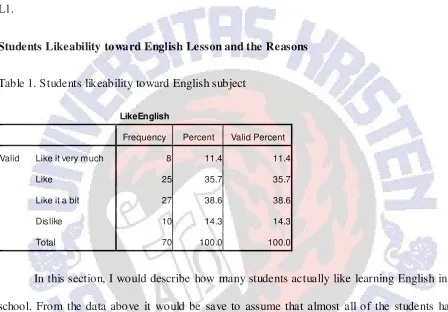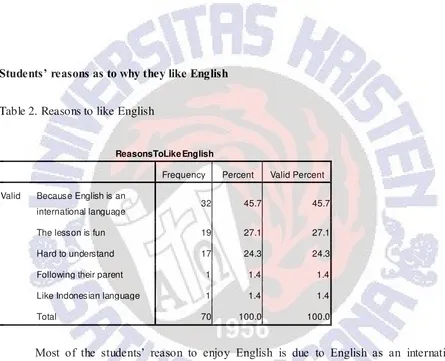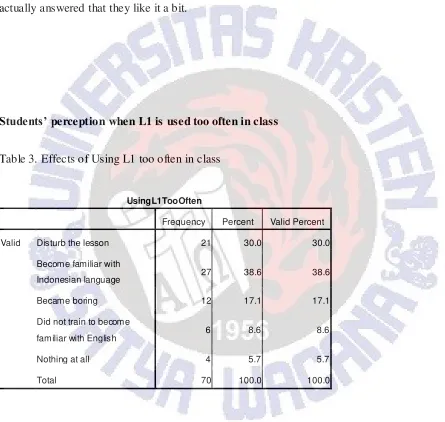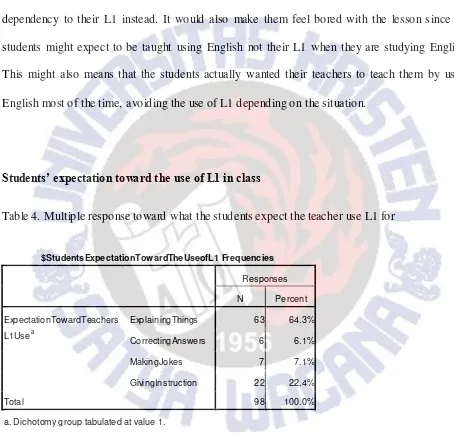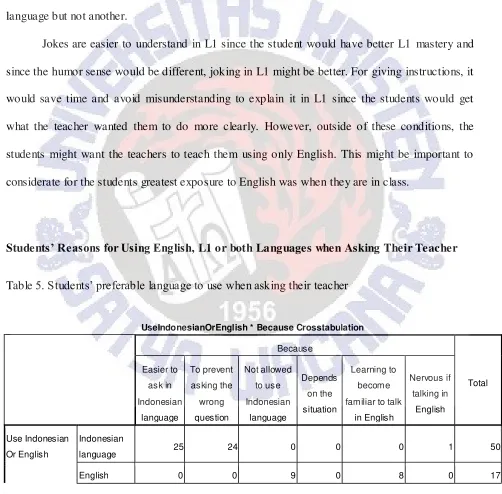STUDENTS’ PERCEPTIONS TOWARD THE USE OF BAHASA INDONESIA IN
TEACHING ENGLISH
THESIS
Submitted in Partial Fulfillment of the Requirements for the Degree of
Sarjana Pendidikan
Heriyanto Irawan 112006042
ENGLISH DEPARTMENT
FACULTY OF LANGUAGE AND LITERATUR E SATYA WACANA CHRISTIAN UNIVERSITY
i
STUDENTS’ PERCEPTIONS TOWARD THE USE OF BAHASA INDONESIA IN
TEACHING ENGLISH
THESIS
Submitted in Partial Fulfillment of the Requirements for the Degree of
Sarjana Pendidikan
Heriyanto Irawan 112006042
ENGLISH DEPARTMENT
FACULTY OF LANGUAGE AND LITERATUR E SATYA WACANA CHRISTIAN UNIVERSITY
1
TABLE OF CONTEN T
Inside cover page i
Approval page ii
Copyright statement iii
Publication agreement declaration iv
Table of content 1
Abstract 2
Introduction 2
The Study 7
Data Analysis 9
Conclusion and Implications 16
Acknowledgement 18
References 19
2
STUDENTS’ PERCEPTIONS TOWARD THE USE OF BAHASA INDONESIA IN
TEACHING ENGLISH Heriyanto Irawan Abstract
English has become one of the major subjects in all schools nowadays and many teaching methods were developed to help teaching English. In opposition of the direct method which has been adopted in educational institutions in Indonesia, to help the students have a better understanding when learning English, another method is used which is by using first language
(L1) to help the students. In this study, I will aim to discover how students actually perceive L1 in their English learning. I wanted to find out how the students would actually perceive L1 in their English learning. The data is collected from the questionnaires that were given to the XII year students which will be analyzed later using SPSS software. One of the findings shows that the students actually perceive L1 as a tool to help them study English better, especially when they would have to ask their teachers something they do not understand. However, the result also shows that if L1 is used too much, the students would then perceive it as an obstacle to their
teaching the students. The other one however, supports and allows the use of L1 in the English
teaching classroom. This might also divide the teachers’ perception into two different points. If they would use only English in the classroo m, then they would perceive L1 as a negative aspect
in their teaching and avoid the use of L1. As the opposite, the teachers who support the use of L1
would perceive it as positive aspect in their teaching, meaning they would use L1 to facilitate the
3
Even though it might be true that by using only English in class, the students would get
more exposure to the language and they would be able to become more familiar with the
language faster. However, if the English proficiency o f the students is not high enough they
would not be able to understand what the teachers explain to them. This, in return, might make
the students dislike or even hate to learn English since it was hard to understand. To prevent this
from happening, one of the methods used in teaching English was to include L1 to facilitate
students learning process. Using this method, the teachers’ perception toward the use of L1 in
teaching gradually changes. Teachers would slowly perceive L1 as a helping tool when teaching
English to the students.
Just as the teachers have their perceptions toward the use of L1, the students also have
their own perception toward the use of L1 in their English learning process. For the students,
they would have more exposure to their L1 compared to English since the most exposure to
English they might get was from the English school teachers.
This study aimed at finding the answer to what actually the students expect from their
English teachers especially in the form of first language use in the classroom. By doing this
study, I hope that English teachers might be able to understand better what their students actually
expect from them. Therefore, this study will aim to answer this following question: ‘What are the students’ perceptions toward the use of first language in teaching English?’
Pros and Cons toward the use of First Language
There has been a belief among English teaching and learning community that using first
4
would have negative effects to the English language learners. Such negative effects were
mentioned by Howatt (1984) and Littlewood (1984). Howatt (1984) mentioned that encouraging
the students to talk in English by giving them freedo m to use their L1 might cause a negative
effect. The negative effect was that it might create a tendency to speak using L1 rather than using
English. This is because the students might feel more comfortable using their L1 rather than
English. Limitation to the use of L1 is important so that the goals of teaching English to the
students might be achieved.
Another negative effect, as stated by Littlewood (1984), was the negative transfer caused
by mistranslation of L1 use. Since the words and grammatical for ms in English were different
from their L1, the students might have a negative transfer of the words and grammatical forms.
One of the examples is word to word translation. When translating the L1 word ‘es teh’ it would turn out to ‘ice tea’ in English which is correct. However, the word ‘teh panas’ would be translated as ‘tea hot’ which is wrong word order in English although it is in a correct order in
L1. Littlewood also stated that in order to arrive at the correct rule for generating correct words
and sentences, the students might need to attend to their English input which the teacher taught
them. They might have to form appropriate patterns to correct their mistakes by remembering
word orders and classifying the words to their correct functions like adjectives, nouns, verbs, etc.
However, there are also some arguments that support the use of L1 in learning a second
language (L2). Krashen (1987) encourages the use of L1 to create a comfortable learning
atmosphere (a low anxiety atmosphere) where the students might find themselves more
comfortable when speaking English. In this case, the students could code-switch the words that
5
the time in the classroom while the students did not know the words for what they wanted to say
the students would not try to speak at all.
In opposition to the negative effect stated by Littlewood, Cook (2001) suggested that L1
should be used to facilitate the learning process. By using L1, students might have a better
understanding toward what they were supposed to learn. Errors might happen of course, but
correcting the errors by using English only might lead to the never ending problem. This is
because the students might not understand what the teacher was explaining to them.
Furthermore, Cook (2001) also suggested that it was better to explain English concepts or words
that were hard to understand using L1 because students would be able to understand better and
they would be able to see the reasons why something had to be done exactly as the teacher taught
them. Explaining things in L1 could also save time for the teacher to do something else.
By using the grammar-translation method when teaching English, L1 would have a great
role in the teaching and learning process since this method relies on the usage of L1 in the
teaching and learning process. With this method, there are several roles that L1 might have.
Krashen (1984) stated two roles that L1 have in teaching English. First, if L1 was allowed to be
used, it might encourage the students to speak up in English even if they did not know the exact
English word, they would try to code-switch and substitute the word in English with their L1 and
then get corrected. By code-switching, the students and their peers would try to understand the
word which is being used and they would probably make fewer mistakes when encountering the
same word. They would also feel relaxed since they would not get punished if their L1 was used
6
The second role, as Scott and Yreberg (1990) mentioned, was that students have a better
understanding when things in L2 were being explained in their L1. This was because students
came to school with their more developed L1 (the older they were the be tter development they
might have). By having their L1 more developed, it might help them to make sense of some
sentences that did not make sense in L2 when the teachers or the students themselves translated
the word in L2 to their L1. This might also help the students to have a positive transfer, as
opposed of negative transfer.
The third role of L1 was based on the contrastive analysis mentioned by Troike (2006).
He mentioned that by comparing the students’ L1 with L2 that they are trying to learn, the
teacher could find the students’ errors (mistakes, things they didn’t understand/things that they found it hard to do) in L2 so that the errors could be corrected quickly and the students might be
able to develop new skills which would enable them to help the mselves when the same errors
themselves. This would lead to the situation becoming awkward because the students might not
be able to say what they actually wanted to say. Another example was when the teachers need to
explain about the difficult grammar and dealing with a serious d iscipline problem e.g. an
7
Method, in which the use of L1 could be avoided from the start, the instructions or explanations
of tasks were sometimes so complex that using only L2 would only lead to problems later.
Another study done by Manara (2007) showed that although monolingual teaching was
preferred in the classroom, there was still a room for L1 usage in classroom activities. Though a
bit different from Littlewood’s and Yu’s study, there were similarities like in the usage of L1 in the classroom for example. Both studies mention the same example in which the teachers’ used
L1 in explaining things that would otherwise cause a problem (inefficient teaching) if it was
explained in L2 only because the things being explained was so complex. Another finding found
by Manara is that the use of L1 would depend on the students’ level of proficiency, meaning that L1 might be used if the students’ level of proficiency is low. On the other hand, as the students’
level of proficiency grows higher, the use of L1 might be lessened. The last finding is that L1
would be used to bridge the students’ L1 knowledge to their L2 learning.
Both studies showed that L1 is actually used in the classroom for reasons that are actually
similar to each other and it caught my interest in doing a similar study, but from the students’ point of view. I attempted to find out the how do the students’ perceive the use of L1 in their
English learning in reality. I tried to see the reasons as to why the students might perceive the use
of L1 as the result of this research.
The Study
Context of the Study
This research took place in SMA Kristen Satya Wacana (Laboratorium UKSW) in
8
in Salatiga that even students outside the city would apply to go and study there. Only 140
students could register to the school which meant that the students’ competition was great and
only the best students would be able to become the school’s students.
Participants
A sampling with 70 XII year students would be chosen randomly from 140 students of
the senior high school that the study would be conducted in. Random sampling would be used
because not all participants might consent to the study so any participant that would consent to
the study would be considered as a sample to participate in the study. XII year students were
chosen because they were in their last year and would be taking the national exams in order to
graduate. Another reason was because they might have a higher English proficiency when
compared to their junior classmen. By doing this research, I wanted to see how they actually
perceive the use of L1 in their English.
Data Collection Instrument
To collect the data required for this research, questionnaires in Indonesian language with
14 open-ended and close-ended questions would be given to the participants. Indonesian
language was chosen to help the students understood the question better so they would not have a
problem answering the questions. The open-ended questions were present since the participants
might have a different answer other than the answers which are provided in the questionnaire.
9
things such as whether they like the English subjects or not with the reasons why. One of the
questions would also cover about the students’ motivation when the teacher taught them using L1, and their opinion about when should teachers use L1 during the class. The other questions
would ask the students what did they think when L1 was used too much during class, did they
see L1 as an obstacle when learning English, and lastly, how they perceive L1 when they had to
ask the teacher.
Data Collection Method
Before the data collection started, a letter informing the school about the research had to
be given to the headmaster. This was to ensure that the school knew about the research so they
would help me in the data collection process. After that, a meeting with the headmaster would
follow to discuss about how the data would be collected. For this research, we agreed that I
would provide the questionnaires and the school teachers would then distribute the
questionnaires to the students during the teaching- learning process. The questionnaires would
then be returned one week later. A total of 85 questionnaires were given to the students, but only
70 were returned. The questionnaires were given without piloting and only the teachers had full
control over how the questionnaires were given.
Data Analysis
The Statistical Package for Social Science (SPSS) program wa s used to analyze the data
acquired from the questionnaires. The main objective of this analysis is to discover students’ perceptions toward the use of L1 in their learning English. The answers of the questionnaires
10
the students likeability toward the English lesson and their reasons as to why they feel that why.
Next is about their motivation when their teacher use L1 in the lesson, and how would they
perceive L1 when it was used too many times in the lesson. The last analysis would discover
their language preference when asking their teacher which would discover whether they perceive
L1.
Students Likeability toward English Lesson and the Reasons
Table 1. Students likeability toward English subject
In this section, I would describe how many students actually like learning English in the
school. From the data above it would be save to assume that almost all of the students had a
positive attitude toward learning English since they liked the subject. This could mean that they
did not feel any burden of learning English in class. The students who liked English might also
prefer to be taught in English and might also perceive L1 as an obstacle in their learning. One of
the reasons as to why L1 might become an obstacle was because one of t he most exposure to
English they could get in school was in the classroom. Although the students who dislike the
subject might prefer to be taught using L1, the students who liked English might also consider to
11
L1 in this case might be able to help them understanding faster so they would be able to spend
more time studying other subjects.
Students’ reasons as to why they like English
Table 2. Reasons to like English
ReasonsToLike English
Frequency Percent Valid Percent
Valid Because English is an
international language 32 45.7 45.7
The lesson is fun 19 27.1 27.1
Hard to understand 17 24.3 24.3
Following their parent 1 1.4 1.4
Like Indonesian language 1 1.4 1.4
Total 70 100.0 100.0
Most of the students’ reason to enjoy English is due to English as an international language. Being an international language, English has become an important thing to learn for
the students’ future. English has become something required for the students later on which
might be the biggest reason why the students like English. To 19 of the students, learning
English were fun because the lesson itself was fun. They consider learning English not as a
12
English all answers that the reasons why was because it was hard for them to understand English.
Not being able to understand something in English would be confusing for them that they might
consider L1 as one of the only way to help them having a better understanding in English. The
rest 7 of the students who answered that they dislike English because it was hard to understand
actually answered that they like it a bit.
Students’ perception when L1 is used too often in class
Table 3. Effects of Using L1 too often in class
UsingL1TooOften
Frequency Percent Valid Percent
Valid Disturb the lesson 21 30.0 30.0
Become familiar with
Indonesian language 27 38.6 38.6
Became boring 12 17.1 17.1
Did not train to become
familiar with English 6 8.6 8.6
Nothing at all 4 5.7 5.7
Total 70 100.0 100.0
Although the use of L1 in the classroom might be useful, when it is used too often or
excessively, the students would start to think of L1 as a hindrance in learning English instead of
13
using L1 too much, the students would not be able to familiarize themselves with English which
especially might happen during speaking and listening sessions. This might be caused by less
English most of the time, avoiding the use of L1 depending on the situation.
Students’ expectation toward the use of L1 in class
Table 4. Multiple response toward what the students expect the teacher use L1 for
$StudentsExpectationTowardTheUseofL1 Frequencies
From the table above, it could be said that the students would prefer their teacher to use
14
they are explaining things that are hard to understand. Using L1 in this case would help the
students to get a better understanding about the things being explained, resulting in the students
making fewer mistakes and perhaps avoiding repetition of explaining again and again, saving the
time for doing something else. Correcting answer might makes more sense when L1 is used since
the difference between the 2 language would be made clearer as to why something work in one
language but not another.
Jokes are easier to understand in L1 since the student would have better L1 mastery and
since the humor sense would be different, joking in L1 might be better. For giving instructions, it
would save time and avoid misunderstanding to explain it in L1 since the students would get
what the teacher wanted them to do more clearly. However, outside of these conditions, the
students might want the teachers to teach them using only English. This might be important to
considerate for the students greatest exposure to English was when they are in class.
Students’ Reasons for Using English, L1 or both Languages when Asking Their Teacher
Table 5. Students’ preferable language to use when asking their teacher
15
Both 0 0 0 3 0 0 3
Total 25 24 9 3 8 1 70
The last analysis would be discussing about the language that the students would have to
use when they must ask something that they did not understand to their teacher. 50 students
choose to use L1 because it is easier to ask in L1 and the questions are more accurate in terms
that they could ask directly what they did not understand without having to translate what they
actually have to ask. This question is based on Troike’s (2006) theory of contrastive analysis. By
asking the teacher in L1 the students were actually comparing the things they did not understand
in English with their L1 knowledge. In this way, the teacher would then be able to find out which
part the students did not understand and the students’ errors as well so that the problem would be able to be corrected quickly and be cleared with less misunderstanding. This way, both the
teachers and the students actually already find a way to deal with the problem that had occurred
and might occur again in the future. This might imply that the teacher would respond them by
explaining things in both L1 and English, making a comparative of the students L1 knowledge
with English.
The reason why 9 of 70 students which use English to ask their teacher about something
they did not understand was because they could not use L1 to ask. Although this might seem to
be forced for these students, I actually agree with the 8 students that state the reason why they
use English to ask their teacher about something they did not understand was to familiarize them
16
would happen, in a case where the students did not know the English words and use L1 instead
of English.
In this way, the students would be forced to learn English by trying to speak using
English. The result of this method depends on the teachers’ strategies of responding to the students’ questions. If the teachers responded to the questions kindly by answering their questions and explaining things clearly and slowly while also correcting the students’ mistakes, the students might find it encouraging asking their teacher using only English. Otherwise, if the
teacher responded in a way that make the students felt like they were being scolded rather than
being given explanation, the students might think that it is hard to ask their teachers or even
troublesome. They might also end up choosing to be silent even if there was something they did
not understand.
Conclusion and Implications
The majority of the XII year students of SMA Kristen Satya Wacana (Laboratirum
UKSW) in Salatiga perceive L1 as a facilitator in their learning, as a tool to help them get a
better understanding when learning English. The use of L1 was actually important in t heir
learning English such as when the teachers were explaining things since the students might not
understand the English words being used in the explanation and using L1 would make things
easier to understand. The use of L1 also saves the time needed in understanding the instructions
17
Another important factor is that by using L1, teachers might be able to avoid inefficient
teaching. The students actually expect their teachers to teach by using both English and L1
depending on the situation. The students expect their teacher to use L1 when the teachers are
explaining things which are hard to understand, making jokes, correcting mistakes and giving
instructions. By using L1 when explaining things, students would be able to understand easier
since they know what it means in their L1. Jokes are also easier to understand in their L1 since
the jokes would be told in words that the student would be able to make sense of, without
worrying that the students might not get the jokes. When correcting mistakes using L1, the
students might be able to see the reason why something was wrong correctly. It also makes more
sense when explained in L1 because the difference would be shown, why it does not work in
English and in their L1. For giving instructions, the more complex the instruction, using L1
would be better so the instructions are understood clearly.
The last important factor to be considered is the use of L1 in students’ questions. Students’ questions would cover things they did not understand. By using L1 as a bridge, they would try to get feedbacks and a contrastive analysis would then happen to help the students
make sense of the things they asked the teachers. For the students who use English to ask t he
teachers, code-switch might still happen since the students might still have something they could
not explain in English so they would still need L1 to convey what they wanted to ask. This was
in accordance with Manara’s findings that if the teachers forced themselves by using only English, it might turn out to be inefficient teaching as the students might misunderstand the
18
The result of this research is limited to the most of XII year students in SMA Kristen
Satya Wacana (Laboratorium UKSW) only. The same thing must not be applied to other schools
or instances because they would have something different from this school, the number of the
students and the students’ preferences would be different. That means more variety to the
answers would be found that would lead to different results. Some things might be similar, but
since nothing is exactly the same, the result of this research should not be generalized and
applied to another school. Further research on how to use L1 as effect ive as possible might be
necessary in order to encourage the students to not use L1 too much in the classroom. By doing
the research, it is hoped that students would be able to maximize the use of their L1 when
19
Acknowledgement
First of all, I would like to thank God who has given me life so I could write this thesis. I
would also like to say thank to my thesis supervisor Mrs. Anita Kurniawati for guiding me to
write the thesis. To my thesis examiner Mrs. Suzana Maria, thank you for reading my thesis and
also thank you for helping me revise my thesis. To my parents who keep supporting me
throughout the writing, especially my mother, thank you so much for your support, I love you so
much. Lastly, to my friends, who have helped me by giving ideas, correcting my mistakes and
cheer me up, thank you. Without you all, I might be under pressured without having someone to
20
REFERENCES
Cook, V.J. (2001). Using the first language in the classroom. London: Pitman
Ellis, Rod (1986). Understanding Second Language Acquisition. Oxford: Oxford University Press.
Ellis, Rod (1997). Second Language Acquisition. Oxford: Oxford University Press.
Howatt, A. (1984). A History of English Language Teaching. Oxford:OUP
Krashen, Stephen D. (1987). Principles and Practice in Second Language Acquisition. New York: Prentice-Hall International.
Littlewood, William T. (1984). Foreign and Second Language Learning. Great Britain: The Pitman Press.
Littlewood, William and Yu, Baohua (2009). First Language and Target Language in the Foreign Language Classroom. Cambridge: Cambridge University Press
Manara, Christine (2007). The Use of L1 Support: Teachers’ and Students’ Opinions and
Practices in an Indonesian Context. The Journal of Asia TEFL Vol. 4, No. 1, pp 145-178 Spring 2007.
Qadri, Tahani (2006). Teachers’ and Students’ Practices and Attitudes Toward Arabic (L1) Use
in ELT. Taken from https://dspace.aus.edu/xmlui/handle/11073/28 (Last visit date April, 14 2013)
Saville- Troike, Muriel (2006). Introducing Second Language Acquisition. New York: Cambridge University Press.
Scott, Wendy A and Yreberg, Lisbeth H (1990). Teaching English to Children. New York: Longman
Tsiplakides, Iakovos and Keramida, Areti (2010). The Relationship between Teacher Expectations and Students Achievement in the Teaching of English as A Foreign Language.
21
2. Apa alasan kamu menyukai atau tidak menyukai pelajaran bahasa inggris?
a. Karena ini adalah bahasa internasional
b. Pelajarannya menyenangkan
c. Sulit dimengerti
d. Lai ya, ……….
3. Apakah penggunaan bahasa inggris secara penuh pada saat pelajaran bahasa inggris membuat kamu bingung?
5. Bagaimanakah perasaan kamu kalau guru menggunakan bahasa Indonesia pada saat pelajaran?
a. Senang
b. Cukup senang
c. Biasa saja
22
6. Apakah boleh seorang guru menggunakan bahasa indonesia pada saat mengajar bahasa
inggris? Mengapa?
c. Penggunaan bahasa inggris secara penuh dapat membuat bingung
d. Penggunaan bahasa Indonesia dapat membuat pelajaran menjadi membosankan
e. Lai ya ………
7. Pada saat apakah seorang guru bahasa inggris diperbolehkan untuk menggunakan bahasa indonesia pada saat mengajar? (boleh pilih lebih dari 1)
a. Menjelaskan sesuatu yang sulit
b. Mengoreksi jawaban yang salah
c. Bercanda
d. Member instruksi / perintah kegiatan yang akan dilakukan
e. Menenangkan kelas yang rebut
f. Lainnya ………
8. Termotivasikah kamu apabila guru bahasa inggris mengajar dengan menggunakan
bahasa selain bahasa inggris?
a. sangat termotivasi
b. termotivasi
c. cukup termotivasi
d. tidak termotivasi
9. Apakah guru menggunakan bahasa indonesia untuk membantu dalam mengajar?
a. selalu
b. sering
c. kadang-kadang
23
10.Apa yang akan terjadi apabila guru terus menerus menggunakan bahasa indonesia pada
saat mengajar?
a. Menganggu dalam pelajaran bahasa inggris
b. Menjadi terbiasa dengan bahasa Indonesia
c. Bosan
d. Lai ya ………
11.Apakah bahasa Indonesia menjadi sebuah penghalang bagi kamu untuk mempelajari bahasa inggris?
a. Ya
b. Tidak
12.Apakah kamu dapat memahami penjelasan guru apabila guru hanya menggunakan
bahasa inggris pada saat mengajar?
a. Ya
b. Cukup paham
c. Sedikit paham
d. Tidak
13.Menurut kamu, apa fungsi bahasa Indonesia dalam belajar bahasa inggris?
a. Membantu yang kurang lancar dalam berbahasa inggris
b. Mempermudah dalam penjelasan
c. Menciptakan suasana kegiatan belajar dan mengajar yang menyenangkan
d. Lai ya, ………
14.Ketika kamu harus bertanya tentang sesuatu yang tidak kamu pahami, kamu
menggunakan bahasa inggris atau bahasa Indonesia? Kenapa?
Bahasa ……….., kare a:
a. Lebih mudah bertanya dalam bahasa Indonesia
b. Supaya tidak salah dengan yang mau ditanyakan
c. Tidak boleh e ggu aka bahasa ……….
